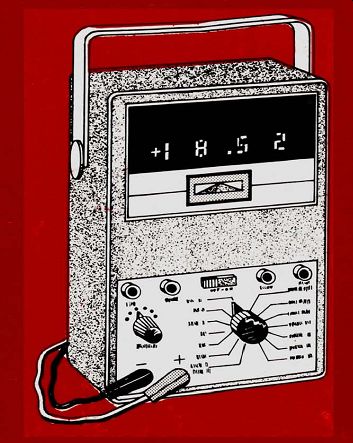- USES OF VOMs AND VTVMs
- VOMs
- INSIDE THE VOM
- PUTTING THE VOM TO WORK
- USE, REPAIR, AND MAINTENANCE
- THE VTVM: HOW IT WORKS
- USING AND CARING FOR THE VTVM
- SOLID-STATE ANALOG VOMs
- DIGITAL VOMs
- ANSWERS to QUESTIONS

Preface
In the past, the volt-ohm-milliammeter (VOM) and the vacuum-tube voltmeter ( VTVM) have been the test instruments used most widely in electrical and electronics work. The VTVM differs from the VOM in that the VTVM includes vacuum-tube circuits for amplification of low-level signals and for otherwise adding to the versatility of the instrument. In recent years, other forms of electronic volt meters have appeared and have become very widely used. These more-recent instruments employ solid-state devices such as transistors or ICs (integrated-circuits) rather than vacuum tubes, and they are generally battery-operated (or offer the choice of either battery or power-line operation ); thus they are advantageous to use when portability is required. The electronic instruments that employ solid state devices (transistors ) are known by such names as "electronic voltmeters" (evm's), "solid-state voltmeters" (ssvm's ), "field-effect transistor voltmeters" (FET vm's ), "field-effect-transistor volt-ohm milli-ammeters" (FET VOM's ), and so on.
The instrument mentioned so far are classified as analog instruments; they employ a pointer and a calibrated scale. The pointer indicates the value being measured along the scale which is marked off from zero to some maximum value. Another general type of instrument which must be considered of equal importance with the analog type is the digital instrument. These are referred to as digital voltmeters (dvm's ) or digital multimeters (dmm's ). Because of the widespread use of analog and digital instruments, it is important to have a thorough knowledge of their features, use, operation, and maintenance. The main purpose of this guide is to provide as much of this knowledge as possible. Discussions of the circuits and of the uses, care, and repair of the instruments are discussed. The major features of the various types are covered, and the advantages and disadvantages are described.
The coverage is practical and relatively basic; the occasional arithmetic employed in the discussions involves only simple calculations. For the benefit of students, hobbyists, experimenters, and beginners, the beginning of the guide reviews basic concepts necessary for understanding electrical measurements. In addition, for the benefit of students and for technicians preparing for employment, licensing, or certification tests, review questions follow each Section, and answers are at the end of the guide.
The author wishes to express his thanks to the International Correspondence Schools division of INTEXT for the use of their library and laboratory facilities; to Pursell Electronics for providing the opportunity to evaluate several instruments from various manufacturers; to Dr. Eugene A. McGinnis, Chairman, Department of Physics, University of Scranton, for advice and guidance; to the manufacturers who freely provided technical research information related to their particular products; to Bill Risse for photographic assistance; and to Ron Lettieri, Tobyhanna Army Depot, for valuable comments.
Back Cover of book: KNOW your VOM- VTVM (THIRD EDITION)
by JOSEPH A. RISSE
Here is an authoritative text that is designed for either self-study or classroom use. It explains volt-ohm-milliammeter ( VOM's), vacuum tube voltmeters ( VTVM's), solid-state electronic voltmeters (ssev's) , and digital VOM's in language anyone can understand. Through the use of a simple non mathematical approach, full details are included on the principles, uses, advantages, disadvantages, and care of both analog and digital VOM's. The guide begins with the different types of meter movements and then goes on to explain the basic purposes and operation of shunts, multipliers, switches, rectifiers, and meter-protection circuits.
The internal and external features of typical VOM's, VTVM's, evm's (electronic voltmeters), and solid-state meters are described in detail, along with the functions and characteristics of all of the important components. Available accessories, such as high-current shunts, test leads, probes, and adapters, are examined.
There are Sections on testing, troubleshooting, repair, and maintenance. These Sections give procedures for capacitance and capacitor leakage measurement, forward and reverse rectifier tests, fuse testing, open-fi lament checks, battery testing, and sensitive-circuit measurements. Procedures are also given for battery replacement, meter movement testing, rectifier replacement, and calibration.
For the benefit of students and for technicians preparing for employment, licensing, or certification tests, review questions are included at the end of each Section, and answers are provided at the end of the guide.
ABOUT THE AUTHOR

Joseph A. Risse is the director of the ICS (International Correspondence Schools) School of Television and is assistant director of the ICS technical schools. His wide experience in electronics, radio, and tv includes six years in broadcasting, three years of which was spent as chief engineer for radio-tv station WHUM AM TV, Reading, Pennsylvania.
At present Mr. Risse serves as tv engineering consultant for the Communications Department at the University of Scranton. He is a fellow of the Society of Broadcast Engineers and a member of the IEEE, AES, and SMPTE. He is editorial director for the SBE, and the author of several books, articles, and instruction texts.
HOWARD W. SAMS & CO. , INC. THE BOBBS-MERRILL CO. , INC. 21134 (Replaces 20676) $5.50. (In Canada $6.60)
Also see: Industrial Electronics (in the early 1960s)
Solid-State Power Supplies and Converters (1974)